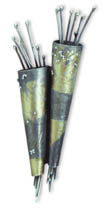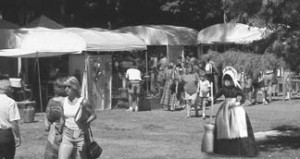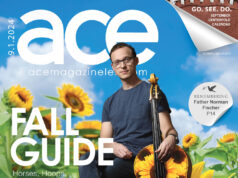It’s not that we hate cornshuck dolls, though we do.
Cornshuck dolls have their place in society. It’s just that the place should not be the annual apex of outdoor art events in Lexington – namely the Woodland Arts Fair.
Common complaints from prior years included: lack of diversity (booth after booth of similarly shaped and styled ceramics); lack of new material (same artists, same art, year after year); and the presence of too many ‘kountry krafts’ (corncob people, mass-produced “authentic rural art”). These three things seem to be challenging the Fair’s basic premise, which is to bring diversity and quality to the art-consuming public.
Looking at last year’s Fair, one might be tempted to hang a genuine kountry “Bless this Mess” sign on the lot.
But steps have been taken to change all that. A committee was formed last year to handle the operation of the WAF, headed by Don Ament. He says, “One of our goals was to [attract] a broader pool of higher quality artists.”
“I could see some things that could be changed last year,” says Polly Singer, simple spectator/customer last year and now the Executive Director of the Lexington Art League. “People said there were too many ceramics, too much this or that… too much ‘crafts-y’ stuff, not what you consider high art.”
too many ceramics, too much this or that… too much ‘crafts-y’ stuff, not what you consider high art.”
For instance, in 1999 there were 30 ceramics booths: a full fifth of the fair and more than leather, metal, photography, sculpture, and drawings booths combined. And it was the same mainstays – 130 artists returning from the previous year, to be exact. And some of them brought their krafts (although Ament denies the presence of cornshuck dolls).
Faced with the problem of purifying the fair, in 1999 the WAF committee changed the system, and the numbers indicate their strategy may be paying off.
In 1999, only 13 percent of the participating artists were new. This year, it’s about 40 percent, says Singer, thanks to the influx of new blood.
As a fundraiser for the Lexington Art League, it’s not surprising that the Woodland Arts Fair once emphasized volume. The LAL, unlike many other art fairs, takes a flat $200 fee from participating artists, and no commission. A virtually open admissions policy ensured more funds.
The Fair reduced its number of booths from 180 in 1998 to 150 in 1999; this year it’s the same. But with the number of applicants up (to 298), Singer and Ament think the weak may have been winnowed out, giving new and better material a chance, thanks to the new annual jury system. The artists are kept on the top of their game by the greater, fiercer competition.
“In the past years, the jurying was done on a three-year basis,” explains Singer. “If you were in, you were in for three years. Now it’s re-juried every year. It really keeps it fresh and up to par. All the good shows are doing that.”
The new jury didn’t take real effect last year, because when the committee was formed, only about 15 spaces were available. But this year, every single artist was juried to cull any slackers from the herd. The art was judged in three categories: design/aesthetics, technique/craftsmanship, and the overall work.
Diversity was also a goal. Ament notes, “After picking the best of all the submissions, we looked at the categories, and made adjustments accordingly.” Many of the commonly lean categories, such as drawings and mixed media have been beefed up… although ceramics still weighs in at 31 booths. Ament explains there were many ceramics entries, and of great quality. The judging panel focused on quality first, then diversity second. Another important aspect was style and individuality.
With a clear idea of what they wanted, the insidious presence of the cornshuck people and their purveyors were ruthlessly toned down (only about 15 booths remain).
Ament points out that there are already plenty of venues for that kind of thing. “The Fourth of July Fair is an unjuried fair that can be a crafts-style event for the more family oriented crowd. Mayfest too,” says Singer. “For the people who want that, they can get it.” So the needs of those who seek bundles of sticks tied together to resemble a horse have already been met. (Irritatingly enough for the WAF committee, shoppers may well find these very krafts set up in surrounding Woodland Park neighborhoods. Everything outside of the park proper is without WAF approval or control. Maps will be available though, clearly displaying the boundaries of what is and is not WAF territory.)
But Ament is quick to point out that the WAF has not adopted a “no crafts” policy. “We’re not trying to drive that out,” he notes.
“We haven’t actually tried to eliminate every aspect of crafts,” he explains. “We have a candle-maker who’s very good. There will even be a dried flower arranger. Her stuff is nicely designed, as art.” He just points out that there is a renewed “emphasis on the fine craft and fine art.”
Which means many regulars didn’t make it in this year, edged out by stiffer or superior competition. Singer tells Darwinian tales of artists who called and begged to be let in, had clients beg, or are simply boycotting the Fair.
By concentrating on having higher quality arts and fine craft, the WAF committee is taking a calculated risk, says Don Ament.
If the public won’t buy the good stuff – which, being good stuff, is naturally more expensive than a corncob painted to look like Hester Prynne – then those artists won’t apply next year, and the juries will have to wade through more junk. And sadly, if the public buys the crap, then the committee will be forced to haul the hacks out each year to make ends meet.
While the Fair wants to be a bastion of fine art and craft – if for every person who buys a $800 oil painting of a Flemish landscape there are a dozen rubes who drove 100 miles for a bushel of potpourri and a squadron of cornshuck people for their little cornshuck villages (whose cornshuck houses may be more tastefully decorated) – the Fair may have to backpedal.
Not that Ament and Singer really expect this to happen. “There’s not too much problem with things getting sold,” says Singer. Ament says most artists can expect to make around $4,000 to $6,000, with some above and below, of course; that average is far easier to reach by painters, sculptors, and jewelers selling high-dollar items as opposed to crocheted toilet-paper cozies.
The expensive, higher end items have found buyers, and consistently at that. Perhaps the greatest test will be in the arrival of Bobby Michelson, a furniture worker from Birmingham, whose works can range into five digit prices. Will Lexington art lovers pay that much anywhere outside a gallery? Organizers are optimistic that the word is out and patrons will arrive, checkbooks in hand.
What the committee didn’t get to implement to full effect last year has occurred for 2000, the twenty-fifth anniversary of the WAF. But even based on the changes made in last year’s show, the WAF has been nominated one of the top 200 art fairs in the nation by Sunshine Magazine, and a voting panel of national artists. There’s no reason that this year’s event shouldn’t show a marked improvement.
But if you see a cornshuck doll, let us know. We have matches.
The Woodland Arts Fair is Friday-Sunday.








